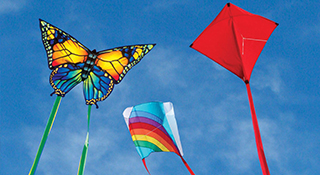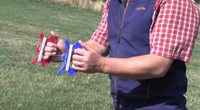Where to Fly
Pick the Right Place to Fly a Kite
Choose an open, treeless area. Trees or buildings upwind can cause ground turbulence and make your kite hard to launch. Downwind, these "kite eating" obstacles can cause turbulence that attracts kites. Hills can be great places to fly kites. Stand on the windward side to avoid turbulence created by the hill itself.
How Much Wind Do You Need to Fly?
Generally less than you think. If you don't have a wind meter, use the Beaufort Scale to judge the wind. Most kiteflying problems are caused by not matching the kite to the wind. If your kite loops and dives while pulling hard on the line, try letting out line. If that steadies it, but only temporarily, the wind is too strong for it. Try adding a tail for more drag. Remember, a tail should add drag not weight. If your kite wobbles and fails to climb unless you keep pulling in line, the wind is too light. Some kites can be adjusted for the wind (see below). If that doesn't work, try a different kite or fly on another day.
Getting Ready
Before Flying Your Kite Get Your Flying Line Ready
If you bought bulk line, transfer it to your reel, using the Slip Knot to attach it to the reel. A snap swivel makes it easy to connect line to your kite and keeps tangles out of your line. If you have a swivel, tie your line to it with the Clinch Knot. If you don't have a swivel, tie the line to your kite with the Bowline Knot.
Before Flying Your Kite Get Your Kite Ready
Read its instructions and assemble it indoors first to see how it's done. Some kites, especially Boxes, can be complicated to assemble. Read the tips below for different types of kites. When you've got your kite and line ready, see How to Launch and Fly Single Line Kites.
Delta Kite Tips
Make sure that the wing spars are pushed all the way out to the wing tips. If there are two holes on the keel, attach your line to the lower hole in light winds and the upper hole in stronger winds.
Deltas are light to moderate wind kites. If your delta pulls hard and loops or dives, the wind is too strong. Adding tails makes deltas easier to launch and fly in gusty winds. Be sure to keep the kite symmetrical, add tails at the center or equally to each side. Don't attach tails to the keel.
Tips for Dragons, Diamonds and Box Kites
Attach your line to the loop on the bridle. You can adjust your kite for stronger or lighter winds by moving the bridle loop. Make sure the factory setting is marked before you move the loop up 1/2" for strong winds or down for light winds.
Tails are needed for most diamond kites; box kites prefer steady winds, and Mylar® Dragons will last longer if you avoid strong winds.
Tips for Airfoil Kites
Attach your line to the bridle loop. Bridle adjustment is not recommended with airfoils. Instead, match your tail to the wind. A streamer tail can be fine in moderate winds, but you may need to change to a drogue tail (picture) in strong winds.
How to Launch
Launching a Kite
To launch in good winds, stand with your back to the wind and hold your kite up to catch the wind. Let line out only as fast as the wind lifts the kite. If the wind lulls, pull in line to make your kite gain altitude.
In light or gusty winds, a high-start launch can get your kite up to steadier winds higher up. Have a friend hold your kite 100-ft. or more downwind from you with the line stretched tight. When your assistant releases the kite, reel in line to make it climb.
Running is the hardest way to launch a kite. The uncontrolled tugging on the line makes kites dive and crash. Let the wind and your reel do the work instead.
How to Fly Your Kite
Line handling lets you control your kite when it's flying. Maintain a steady line tension to keep it flying evenly. Take in line to move it in the direction it's pointing. Let out line to change its direction. Play with it. It's fun!
Also use the line to keep in touch with your kite. If the line goes slack, the wind has lulled. Reel in line to slow the kite's descent. If the pull on your line increases, check to see if a gust is causing your kite to loop or dive. Let out line to help it recover or soften its landing. Always leave some line on your reel for unexpected gusts.
If your line tangles with another kiteline, hold your line steady and walk toward the other flyer. The tangle will move down the lines so that it can be undone.
Landing Tips
In moderate winds, just reel in your kite slowly, pausing if too much tension causes it to loop. With a hard pulling kite, walk it down. While a friend holds the reel, put the line under your arm or hold it with a gloved hand and walk toward the kite. This brings it in without increasing the apparent wind speed.
Winding in Your Line
Keep some tension on the line when winding it in, as loosely wound line tends to tangle. When winding onto a spool with your hand, turn the spool over from time to time and wind in the other direction. This keeps the line from being twisted so many times that it tangles.
Never struggle to reel in your kite. Reeling in line under strong tension could damage the reel. In strong winds, walk your kite down or pull the line in with your gloved hands, while moving around to avoid piling up line in one place. Then wind the line onto your reel.


